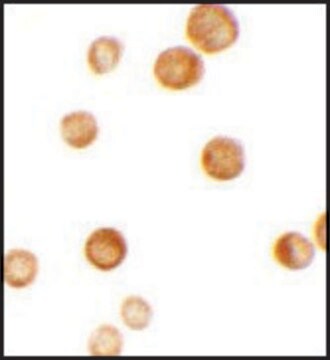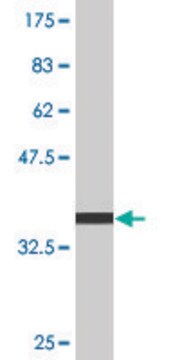HPA019589
Anti-MIER1 antibody produced in rabbit

Prestige Antibodies® Powered by Atlas Antibodies, affinity isolated antibody, buffered aqueous glycerol solution
同義詞:
Anti-Early response 1, Anti-Er1, Anti-Mesoderm induction early response protein 1, Anti-Mi-er1, Anti-hmi-er1
登入查看組織和合約定價
全部照片(7)
About This Item
推薦產品
生物源
rabbit
品質等級
共軛
unconjugated
抗體表格
affinity isolated antibody
抗體產品種類
primary antibodies
無性繁殖
polyclonal
產品線
Prestige Antibodies® Powered by Atlas Antibodies
形狀
buffered aqueous glycerol solution
物種活性
human
加強驗證
orthogonal RNAseq
Learn more about Antibody Enhanced Validation
技術
immunofluorescence: 0.25-2 μg/mL
immunohistochemistry: 1:50-1:200
免疫原序列
MMEGETNFSSEIEDLAREGDMPIHELLSLYGYGSTVRLPEEDEEEEEEEEEGEDDEDADNDDNSGCSGENKEENIKDSSGQEDETQSSNDDPSQSVASQDAQEI
UniProt登錄號
運輸包裝
wet ice
儲存溫度
−20°C
目標翻譯後修改
unmodified
基因資訊
human ... MIER1(57708)
一般說明
MIER1 (Mesoderm induction early response 1) is a nuclear protein isolated from Xenopus laevis embryonic cells as a fibroblast growth factor early response gene. It has two isoforms, MIER1 α and β. In humans, it is expressed in all tumor cell lines and tumor tissue.
免疫原
Mesoderm induction early response protein 1 recombinant protein epitope signature tag (PrEST)
應用
All Prestige Antibodies Powered by Atlas Antibodies are developed and validated by the Human Protein Atlas (HPA) project and as a result, are supported by the most extensive characterization in the industry.
The Human Protein Atlas project can be subdivided into three efforts: Human Tissue Atlas, Cancer Atlas, and Human Cell Atlas. The antibodies that have been generated in support of the Tissue and Cancer Atlas projects have been tested by immunohistochemistry against hundreds of normal and disease tissues and through the recent efforts of the Human Cell Atlas project, many have been characterized by immunofluorescence to map the human proteome not only at the tissue level but now at the subcellular level. These images and the collection of this vast data set can be viewed on the Human Protein Atlas (HPA) site by clicking on the Image Gallery link. We also provide Prestige Antibodies® protocols and other useful information.
The Human Protein Atlas project can be subdivided into three efforts: Human Tissue Atlas, Cancer Atlas, and Human Cell Atlas. The antibodies that have been generated in support of the Tissue and Cancer Atlas projects have been tested by immunohistochemistry against hundreds of normal and disease tissues and through the recent efforts of the Human Cell Atlas project, many have been characterized by immunofluorescence to map the human proteome not only at the tissue level but now at the subcellular level. These images and the collection of this vast data set can be viewed on the Human Protein Atlas (HPA) site by clicking on the Image Gallery link. We also provide Prestige Antibodies® protocols and other useful information.
生化/生理作用
MIER1 (Mesoderm induction early response 1) is a transcriptional regulator that may repress transcription by blocking the function of histone acetyltransferase. It participates in the chromatin remodeling by interacting with Creb-binding protein (CBP). Its N-terminal domain interacts with CBP, which further brings about acidic activation. During transcriptional regulation, it binds to the GAL4 DNA binding domain to repress transcriptional signals. Study shows that MIER1 expression is linked to the neoplastic state of human breast carcinoma.
特點和優勢
Prestige Antibodies® are highly characterized and extensively validated antibodies with the added benefit of all available characterization data for each target being accessible via the Human Protein Atlas portal linked just below the product name at the top of this page. The uniqueness and low cross-reactivity of the Prestige Antibodies® to other proteins are due to a thorough selection of antigen regions, affinity purification, and stringent selection. Prestige antigen controls are available for every corresponding Prestige Antibody and can be found in the linkage section.
Every Prestige Antibody is tested in the following ways:
Every Prestige Antibody is tested in the following ways:
- IHC tissue array of 44 normal human tissues and 20 of the most common cancer type tissues.
- Protein array of 364 human recombinant protein fragments.
聯結
Corresponding Antigen APREST73798
外觀
Solution in phosphate-buffered saline, pH 7.2, containing 40% glycerol and 0.02% sodium azide
法律資訊
Prestige Antibodies is a registered trademark of Merck KGaA, Darmstadt, Germany
免責聲明
Unless otherwise stated in our catalog or other company documentation accompanying the product(s), our products are intended for research use only and are not to be used for any other purpose, which includes but is not limited to, unauthorized commercial uses, in vitro diagnostic uses, ex vivo or in vivo therapeutic uses or any type of consumption or application to humans or animals.
未找到適合的產品?
試用我們的產品選擇工具.
儲存類別代碼
10 - Combustible liquids
水污染物質分類(WGK)
WGK 1
閃點(°F)
Not applicable
閃點(°C)
Not applicable
Goran Lakisic et al.
PLoS genetics, 12(3), e1005898-e1005898 (2016-03-05)
BAHD1 is a vertebrate protein that promotes heterochromatin formation and gene repression in association with several epigenetic regulators. However, its physiological roles remain unknown. Here, we demonstrate that ablation of the Bahd1 gene results in hypocholesterolemia, hypoglycemia and decreased body
G D Paterno et al.
Gene, 222(1), 77-82 (1998-11-14)
We recently cloned and characterized a novel immediate-early gene, called er1, from Xenopus embryos whose expression levels were increased during mesoderm induction by fibroblast growth factor (FGF). We describe here the isolation and expression pattern of the human er1 sequence.
Tina M Blackmore et al.
BMC research notes, 1, 68-68 (2008-08-30)
Mier1 encodes a novel transcriptional regulator and was originally isolated as a fibroblast growth factor early response gene. Two major protein isoforms have been identified, MIER1alpha and beta, which differ in their C-terminal sequence. Previously, we demonstrated that both isoforms
Zhihu Ding et al.
Molecular and cellular biology, 23(1), 250-258 (2002-12-17)
mi-er1 (previously called er1) was first isolated from Xenopus laevis embryonic cells as a novel fibroblast growth factor-regulated immediate-early gene. Xmi-er1 was shown to encode a nuclear protein with an N-terminal acidic transcription activation domain. The human orthologue of mi-er1
我們的科學家團隊在所有研究領域都有豐富的經驗,包括生命科學、材料科學、化學合成、色譜、分析等.
聯絡技術服務








